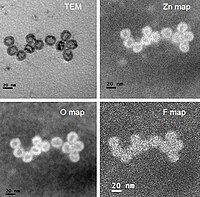
Photo from wikipedia
In the present work, we report the use of bacterial cells for the production of CdS/CdSe Core/Shell quantum dots (QDs), a complex nanostructure specially designed to improve their performance as… Click to show full abstract
In the present work, we report the use of bacterial cells for the production of CdS/CdSe Core/Shell quantum dots (QDs), a complex nanostructure specially designed to improve their performance as photosensitizer in photovoltaic devices. The method requires the incorporation of L-cysteine, CdCl2 and Na2SeO3 to Escherichia coli cultures and allows a tight control of QDs properties. The obtained CdS/CdSe QDs were photophysically and structurally characterized. When compared to CdS QDs, the classical shift in the UV-visible spectra of Core/Shell nanostructures was observed in CdS/CdSe QDs. The nanosize, structure, and composition of Core/Shell QDs were confirmed by TEM and EDS analysis. QDs presented a size of approximately 12 nm (CdS) and 17 nm (CdS/CdSe) as determined by dynamic light scattering (DLS), whereas the fourier transform infrared (FTIR) spectra allowed to distinguish the presence of different biomolecules bound to both types of nanoparticles. An increased photostability was observed in CdS/CdSe nanoparticles when compared to CdS QDs. Finally, biosynthesized CdS/CdSe Core/Shell QDs were used as photosensitizers for quantum dots sensitized solar cells (QDSSCs) and their photovoltaic parameters determined. As expected, the efficiency of solar cells sensitized with biological CdS/CdSe QDs increased almost 2.5 times when compared to cells sensitized with CdS QDs. This work is the first report of biological synthesis of CdS/CdSe Core/Shell QDs using bacterial cells and represents a significant contribution to the development of green and low-cost photovoltaic technologies.
Journal Title: Frontiers in Microbiology
Year Published: 2019
Link to full text (if available)
Share on Social Media: Sign Up to like & get
recommendations!